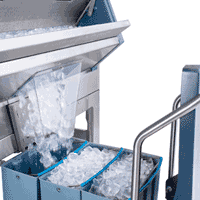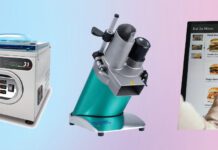Choosing the right ice machine means researching everything from performance to maintenance.
There’s nothing sleek or sexy about ice machines, but, with proper care and maintenance, the clunky workhorses can soldier on for some 15 years. The biggest challenge is sorting through the literature and advice to find the right piece of equipment to get the job done.
As with any big appliance, finding a machine that reduces energy and water efficiency is a huge consideration as is its configuration and mechanics. But, operators also need to determine what type of ice is needed in terms of size, shape and quality. From large blocks to cubes, half-moons and flakes, sometimes the shape and size is a question of form rather than function. “We’re seeing continued interest in ice as an ingredient and not just a cooling device,” notes John Sara, senior product manager for Manitowoc Ice in Manitowoc, Wis.
MECHANICAL GENIUS
“The major consideration with ice machines is energy and water consumption,” explains Steve Follett of Follett Corporation in Easton, Penn. To that end, most manufacturers are ensuring new products meet Energy Star guidelines. “Almost all [new] ice machines, if not a good majority, are Energy Star approved now,” adds Murray Gamble, president of Manco Distributors in Toronto.
That doesn’t mean environmentally sound machines are always the answer. “Everybody’s pushing green. But it also has to fit financially with your plan,” cautions Ryan Kelly, purchasing manager, Capital Projects for Westmont Hospitality Group in Mississauga, Ont.
In addition to the expense, once the machine is in place, noise may be an issue, so Follett recommends using a remote feed from the ice machine to the beverage tower or dispensing unit. Some operators put their condensing units on the roof to reduce noise and save space. Either way, sizing a machine is a critical consideration. “In many cases, operators tend to oversize their units based on peak demand,” Follett says. And, although that may be a hard problem to rectify, there are ways to increase capacity on small machines. One way to save on upgrade costs is to replace your bin, Manitowoc’s Sara advises. “If you find capacity is running short, sometimes the most cost-effective solution is to supersize your bin and build up reserve capacity for busier times.”
At The Fairmont Hotel Vancouver Airport, the ice machine that services heart-of-house needs in the hotel’s kitchens and bars has been sized to hold two compressors on top of a single bin so both can run during peak times and cycle individually overnight, explains Mike Brown, chief engineer.
When it comes to dispensing features, the choice will depend on the machine’s frequency of use and the time stored. “If ice sits in a bin for a long time, it can pick up odours and get stale,” Follett warns. This can be alleviated by purchasing a unit that dispenses ice from the bottom so ice is continuously refreshed.
Generally, design choices include two-component units in which the compressor is separated from the storage bin. These are typically used at larger restaurants and quick-service operations, explains Manco’s Gamble. Smaller applications tend to work well with all-in-one, self-contained units that can be kept under the counter or in smaller areas.
In terms of performance, air-cooled systems are more prevalent than water-cooled, given the increase in municipal tariffs on water consumption. Air-cooled units, however, generate heat, so they should be installed in areas where there is plenty of air circulation, Gamble says. That’s why operators should choose the machine that works best with their environment.
“In Vancouver, where there are fewer fluctuations in the weather, air-cooled makes more sense,” Capital’s Kelly explains. “In other places, water-cooled is better because you don’t have to work as hard to draw outside elements to maintain it — unless you’re dealing with local water restriction regulations; then it becomes a cost-revenue issue.”
At Booster Juice, Len Hoang, training manager, notes that while the company usually purchases Scotsman air-cooled ice makers for its operations, water-cooled units are used at locations that don’t have proper ventilation. Water-cooled or not, every machine should carry a warranty, which can vary depending on the components in question. For example, augurs, a specific part of flakers, typically come with a one-year warranty due to wear and tear, while other components may be guaranteed for up to five years.
GETTING IN SHAPE
When it comes to ice consumption, operators are showing interest in nugget and smaller shaped products, according to Follett. “More and more people want smaller ice nuggets in their dispensers, because they’re finding consumers like to chew ice.” “We’re seeing that trend in healthcare,” Manco’s Gamble confirms. “For that you need a softer cube. Half-size is also being used for blended drinks such as smoothies.” (see sidebar for soft-ice specifications)
HARD FACTS ABOUT SOFT ICE
Converting hard water to soft water is as easy as buying a piece of equipment, but soft ice cubes and hard ice cubes are a result of the ratio of ice to water. Soft chewable cubes, popular at healthcare institutions, for example, are made using about 83 per cent ice to water ratio, according to Murray Gamble, president of Manco Distributors in Toronto. More specifically, “cubes for drinks in a bar are usually around 98 per cent [ice to water] because they’re harder and last longer; flake machine ice is typically 65 per cent [ice to water],” Gamble adds.
On the other hand, when it comes to high-end drinks, presentation and durability are critical. In fact, John Silva, owner of The Iceman in Toronto, a distributor of ice and ice-making machines, says there’s a growing interest in using large cubes — about 1 1/4 inches and up — for mixed drinks. It’s a trend that’s evident at The Iceman, too. The company produces a twoinch cube variation from 300-lb blocks produced by its Clinebell Carving Block Maker.
Meanwhile, Silva is partial to Kold-Draft, because of its ability to make large, clear, straight-sided cubes; another of his favourites is a series from Hoshizaki that turns out a half-moon shape.
John Fragomeni, founder of the Toronto Institute of Bartending, has his own preferences. “We’re always looking for good, hard ice that’s not hollow on the inside, isn’t flat or flaky and won’t dilute the ingredients in the glass; the best shape is a good-sized square. Kold-Draft makes the best cubes,” he says. His latest wish-list discovery is an iceball mould machine from Japan that reshapes large cubes into perfect spheres.
The copper unit from Taisin Production Co., Limited has a water-cooled jacket and can produce a perfect ice ball in 20 seconds.
WEAR AND CARE
An ice machine is a significant investment — with small under-the-counter units rnging in price from $1,300 to $6,000, and large commercial units costing upwards of $14,000 — so ongoing maintenance is critical. Air-cooled units need to be cleaned regularly, Silva advises. “If you don’t, it’s like trying to breathe with a bag over your head. Once a year you should de-scale the evaporator as well. Also, keep your unit away from areas where there is a lot of flour, or where empty beer bottles are stored, since the yeast will gum up the machine over time.”
Booster Juice’s air filters are typically cleaned monthly and replaced over a sixmonth timeframe. “We also de-scale the units every three to six months depending on the quality of the water,” Hoang adds.
The management at Fairmont Vancouver Airport prefer to accelerate the maintenance schedule to ensure its 11-year-old Hoshizaki units run smoothly, Brown adds. “Doing it often increases reliability and means the ice is always clear. We also replace all four filters every three months. While filters are $100 apiece, the investment is worth it when we consider a new unit would cost about $30,000.”
Choosing and maintaining an ice machine is not as easy as it seems, but the more informed operators are about the science behind the equipment, the more likely they will keep a cool head and make the right purchasing decision.
VENDOR INFORMATION
Check out the cheatsheet below for ice-machine vendors and their coordinates:
Manitowoc Ice (manitowocice.com)
Follett (follettice.com)
Kold-Draft (kold-draft.com)
Scotsman Ice Systems (scotsman-ice.com)
Clinebell Equipment Company (clinebellequipment.com)
Hoshizaki America, Inc. (hoshizakiamerica.com)
Taisin Production Co., Ltd. (taisin-ss.co.jp/icemold/english/index.html)
For a complete supplier’s list, check the online Buyer’s Guide at foodserviceandhospitality.com.





















